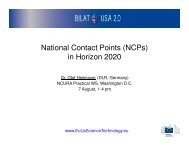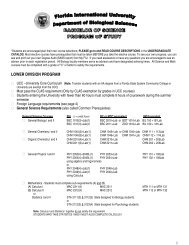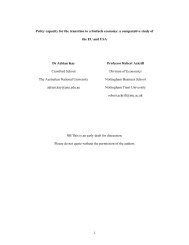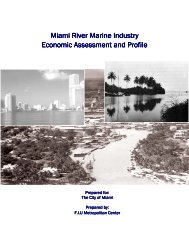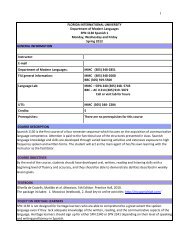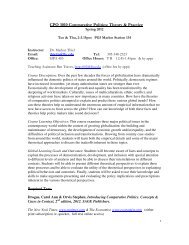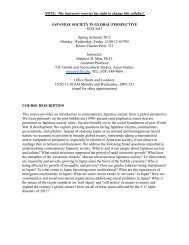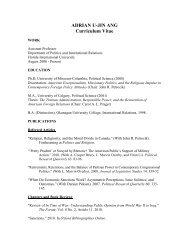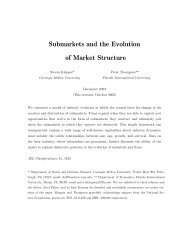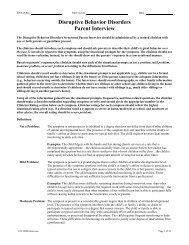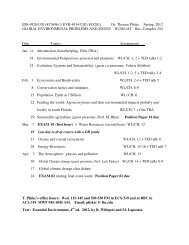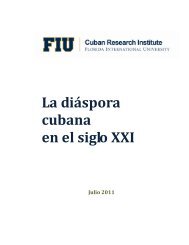Second Annual IFRI Forensic Science Symposium - College of Arts ...
Second Annual IFRI Forensic Science Symposium - College of Arts ...
Second Annual IFRI Forensic Science Symposium - College of Arts ...
You also want an ePaper? Increase the reach of your titles
YUMPU automatically turns print PDFs into web optimized ePapers that Google loves.
<strong>Second</strong> <strong>Annual</strong> <strong>IFRI</strong> <strong>Forensic</strong> <strong>Science</strong> <strong>Symposium</strong> • March 13 - 14, 2013<br />
mostly based on GC-MS. In this study, we illustrate the use <strong>of</strong> GC triple quadrupole mass spectrometer (GC-QQQ) with extracts <strong>of</strong> the weathered oils.<br />
The GC-QQQ operated in the multiple reaction monitoring (MRM) mode has shown to have advantageous for some <strong>of</strong> the biomarkers over the traditional<br />
GC-MS operated in full scan or SIM mode due to the selectivity <strong>of</strong> the GC-QQQ.<br />
18. The Development <strong>of</strong> Field Calibrants fir Detection Canines<br />
Katylynn Beltz, Michelle Cerreta and Kenneth G. Furton, International <strong>Forensic</strong> Research Institute<br />
Biological detectors such as canines are valuable tools used for the rapid identification <strong>of</strong> illicit materials because they can be trained to reliably detect<br />
a wide variety <strong>of</strong> odors. However, increased scrutiny over the reliability <strong>of</strong> detection canines is currently being evaluated in the legal system as there are<br />
no formal regulations regarding detection canine maintenance and training. This study deals directly with the steps taken for the validation <strong>of</strong> surrogate<br />
continuation aids and a Universal Detector Calibrant (UDC). The development <strong>of</strong> a UDC allows for the determination <strong>of</strong> the reliability <strong>of</strong> the biological and<br />
instrumental detectors on a daily basis. By training the canine to alert to the UDC before each working day the handler can record if the biological detector<br />
is working at suitable standards. Standardization <strong>of</strong> detection canine training aids will ensure the optimal number <strong>of</strong> illicit material odors detectable in the<br />
most reliable manner.<br />
19. Comprehensive Screening and Quantitation <strong>of</strong> Designer Drugs by LC-QQQ-MS/MS Analysis<br />
Ana-Michelle J. Broomes, Luis E. Arroyo-Mora, Anthony P. DeCaprio, International <strong>Forensic</strong> Research Institute<br />
A comprehensive mass spectrometric analytical method for the separation and identification <strong>of</strong> 23 recently schedule designer drugs by the DEA and 12<br />
compounds from the Japan controlled substance list is presented. A triggered multiple reaction monitoring method (tMRM), with up to 10 ion transitions<br />
are incorporated into a customized database to allow identification via a score match. The chromatographic separation <strong>of</strong> the target analytes was<br />
achieved by using a Zorbax Eclipse Plus C18 column, 2.1 x 100mm, 1.8 µm using a methanol water gradient mobile phase. This allows separation <strong>of</strong><br />
all DEA and Japan drug entities in less than 16 minutes for each schedule group. Acceptable linearity (r2>0.99) and excellent detection limits in the low<br />
parts per billion range were obtained for the majority <strong>of</strong> the investigated analytes. This method will ultimately be expanded to include several hundred<br />
designer drug analytes in a single analytical run.<br />
20. Development <strong>of</strong> a High Resolution MS/MS Spectral Library and a<br />
Compound Database for the Identification <strong>of</strong> Designer Drugs by LC-QTOF-MS.<br />
Joshua Z. Seither, Luis E. Arroyo-Mora, Anthony P. DeCaprio, International <strong>Forensic</strong> Research Institute<br />
With the recent rise in popularity and use <strong>of</strong> designer drugs, a need is created within the forensic science community to be able to comprehensively<br />
screen for designer drugs. The LC-QTOF-MS has been suggested to be a useful tool for screening designer drugs. A high resolution MS/MS designer<br />
drug spectral library was created with a LC-QTOF-MS. The high resolution spectral library contained 263 designer drug standards from different classes<br />
such as cathinones, piperazines, phenethylamines, tryptamines and synthetic cannabinoids. In addition to the spectral library a compound database was<br />
created in order to enhance the screening potential. This compound database has chemical information for 500 additional designer drug compounds that<br />
can be used to help aid in the identification <strong>of</strong> designer drugs in a full mass scan. The combination <strong>of</strong> a high resolution MS/MS library and a compound<br />
database could be a very useful tool for the identification <strong>of</strong> designer drugs.<br />
21. Immunomagnetic capturing (IMC) procedure for separation <strong>of</strong> the sperm fraction out <strong>of</strong> mixed (vaginal epithelial and sperm cells) samples.<br />
Pero Dimsoski, Vanessa Martinez, and Bruce R. McCord, International <strong>Forensic</strong> Research Institute<br />
A male genotype was separated from mixed samples using IMC procedure where vaginal epithelial cells were removed from mocked mixed sample by<br />
targeting them with antibodies specific for the epithelial cells. The antibodies, attached to tetrameric complexes integrating magnetic nano-particles<br />
(EasySep kit, Stemcell Technologies), were separated magnetically. The sperm fraction was washed out <strong>of</strong> the tube and the DNA was extracted either by<br />
ethanol precipitation with addition <strong>of</strong> pressure cycling step (Pressure Barocylcer NEP2320, Pressure Biosciences Inc.) or by DNA Investigator kit used with<br />
EZ1 robot (Qiagen). PowerPlex 16 kit (Promega) amplified the DNA which was genotyped on AB310 Genetic Analyzer and a male genotype was obtained.<br />
22. AP endonuclease 1 sustains the fidelity <strong>of</strong> DNA polymerase β during repair <strong>of</strong> an abasic lesion in the context <strong>of</strong> a T/G mismatch<br />
Jing Zhou, Florida International University<br />
The cytosines <strong>of</strong> multiple CpGs located in gene promoters and encoding regions can be methylated at their 5-position to result in a specific pattern<br />
<strong>of</strong> DNA methylation (5-mC). CpG clusters have been identified as the hotspots <strong>of</strong> oxidative DNA damage and mutagenesis. DNA base excision repair<br />
(BER) can remove the damage on CpGs, thereby sustaining normal DNA methylation pattern. BER can also mediate active DNA demethylation, where<br />
a 5-mC is converted into a thymine introducing a T/G mismatch adjacent to a guanine that can be damaged by oxidative stress. In this study, we found<br />
that thymine DNA glycosylase was completely inhibited by an abasic site adjacent to a T/G mismatch. However, AP endonuclease 1 (APE1) efficiently<br />
5’-incised the lesion. Surprisingly, we found that DNA polymerase β efficiently extended the 3’-terminus mismatched T. Interestingly, we found that APE1<br />
3’-5’ exonuclease removed the 3’-T/G mismatch efficiently, thus enhanced pol β fidelity.<br />
Hosted by Florida International University | 9



